If you really want to throw a party and prepare a meal for 100 people, please read on.
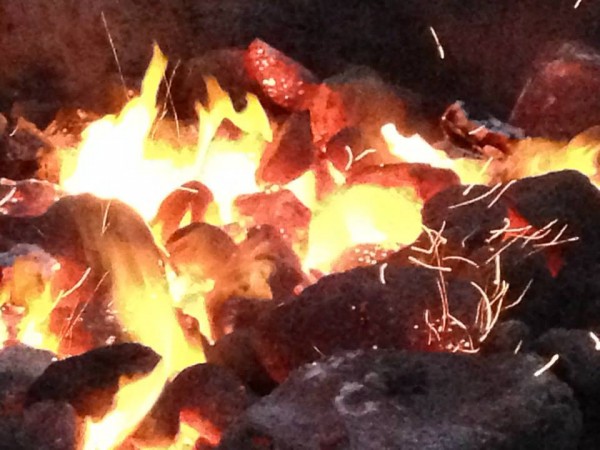
5 hours after lighting the fire
I participated in my first Imu (in-the-ground hot rock oven) in 1984 celebrating the 1st birthday of my son, Jeremy. Naess Betts, a Hapa-Hawaiian friend of mine, showed me how to make an Imu, and since that time, I have helped prepare over 40 of them with some variations. The objective is to be able to cook large quantities of just about anything by steaming them over red hot rocks, buried in the ground.
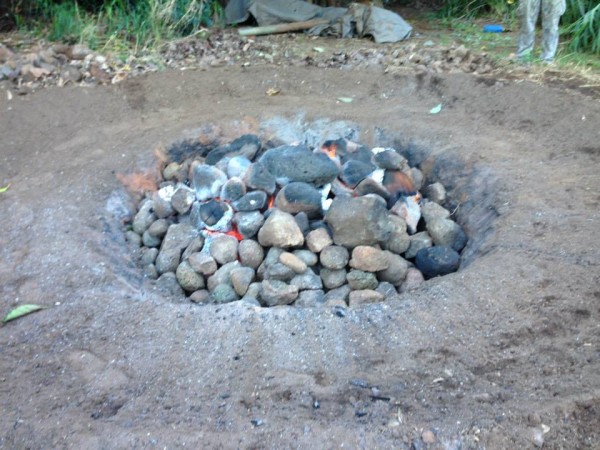
What You Need
- A large hole in the ground about 2 to 3 feet deep and at least 4 feet wide. It can be much larger depending on the proposed volume. We have cooked over 500 pounds of turkeys at one time.
- A big pile of “puka” rocks. Round, weathered volcanic rocks filled with air pockets off the beach or from some stream.
- Lots of Kiawe (mesquite) wood, at least a couple of big wheelbarrows
- 3 or more banana trees and as many banana leaves as you can get
- As many ti leaves as you can get (they add flavor)
- Some fire starter kindling: rolled up newspaper, chopped up pallets, 4-inch cardboard carpet tube, 1 quart denatured alcohol, large coffee can
- Tarps: painting tarps, burlap bags, and plastic tarps can be used
- Chicken wire and farm fence wire to make small and large food “cages,” or baskets to hold the food
- Whatever you want to cook: breadfruit, yams, pork, fish, chicken (roosters are good), turkeys
- Lots of people to help and a cooler full of beer
Preparing the Imu
To prepare the Imu: Dig the hole and keep all the loose dirt 2 feet from the hole, completely surrounding the hole, to be used to cover the edges of the tarps. Cut banana stumps into 3-foot long sections and shred into large piles. You can never get enough because they end up on top of the red hot rocks and provide the steam to cook. Make a huge pile of banana leaves. Keep all of this by the hole with the tarps. Have a water hose ready to wet down the tarps after you load it.
Loading the Imu is as follows: In the bottom of the hole, place the coffee can and put the 6-foot long cardboard tube in the can vertically. Take a wheelbarrow full of rolled up newspapers and pile them around the can and tube. In a criss-cross pattern, put small branches or pallet wood around the cardboard tube and newspaper to support the tube. Next, take smaller Kiawe branches and stack them teepee-style around the cardboard tube. It should now look like a teepee stuffed with newspaper. Follow this with larger Kiawe wood out to the edge of the hole.
Rocks are the next item to load. Carefully place the largest rocks in the middle as close to the tube as possible. It is fine to add some more Kiawe wood intermixed with progressively smaller rocks to fill in the gaps. When you are finished, you should have a pile at least 4 feet high and maybe a lot higher. It is now ready to light.
Lighting it is easy: Pour the alcohol down the cardboard tube in the can. Roll up a paper towel and pour a little alcohol on it; roll up a small rock in the towel, light it, and drop it down the tube. Do not under any circumstances use gasoline, paint thinner, or diesel. You will either blow yourself up or the Imu food will taste like a truck stop. (I learned the hard way.) Pretty soon the fire will light up and start getting hot fast. Ideally, you should have enough Kiawe wood to burn for about 5 hours, to get the rocks red hot. Now it is time to get to work on preparing the food to go inside the Imu.
Food Preparation
For all food there are a few key things to think about. All food should be very clean, all hands should be washed many times in the process, and all tables should be washed with bleach water. We set up a few tables and have the pre-cut chicken wire in 24-inch squares ready to roll up turkeys, pork butts, eggplants, yams, or whatever you want to cook. You can even do a whole pig if you want, but in a larger “cage.”
You place the wire on the table, drop in a double layer of washed ti leaves, put in the item, salt or season as you wish, put on another layer of ti leaves, and cinch the chicken wire into a tight basket or “cage.” If you want to put anything in an aluminum pan, it is fine, but it has to be loaded in the top of the Imu or all the salt and juices from everything on top will drip down. Do not stuff turkeys! They may not get cooked properly if they are large and stuffed. Turkey sashimi is overrated.
After you have all of your small “cages” ready, it is time to load them in the larger carrying baskets. Take a large piece of farm fencing that is 4 feet high and at least 5 feet long. Lay it on your table. Fill it up with a couple of layers of banana leaves and some more ti leaves. Drop in all of your cages. Add more banana and ti leaves and close up the basket with wire ties. It is ready to cook.
Loading the Imu with Food
Take your large basket(s) to the Imu. The wood should be almost 100% burned and the rocks should be red hot. You will need to wear boots and gloves to load the Imu. Rake all the rocks level (this is a very hot job). Take shifts and share the work. Keep several people close by for safety and all children far away. When the rocks are level, start piling the shredded banana stumps on top of the rocks. They should be at least 12 inches thick; more is better. You are ready to load the large baskets.
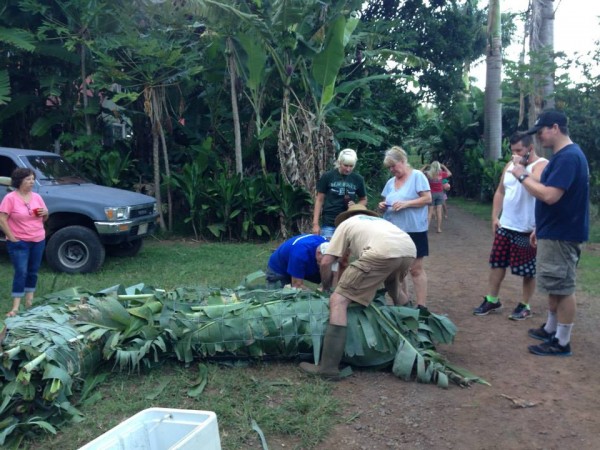
The small “cages” are loaded inside this big basket
Center the large baskets over the rocks. It is fine to pile one basket on top of another if you need more room, but remember to load any “cages” that have aluminum pans on the very top. If you want a turkey with juices, this is how you get one, otherwise they soak down into the rocks. Now you start piling on layers of banana leaves. More is better. Wet the burlap bags or cloth tarps and (over) the banana leaves. Two or three layers is good. Start adding clean plastic tarps. (Old tarps with holes go on first.) The last two tarps have to be large enough to cover the entire Imu with no gaps.
Now you have to seal the edges of the tarps with dirt. Take the dirt you saved around the edge and cover only the edges. There is no need to cover the tarps on top. Wet the edges, get a beer, and wait. You have to stay with the fire for about an hour or so to make sure you don’t get any burn-throughs in the tarps or “steamers” on the edges. The tarps should be pushing up like a big balloon at this point, if you did it correctly.
Cooking time: I always try to load the Imu right before dark and stay with it for awhile. You can leave it in the ground for 15 hours if you want because it can’t overcook as the heat gradually drops the whole time. We usually open it up the following day around noon. The minimum time in the ground should be 6 or 7 hours though.
Opening It Up
This part is easy. Clear the dirt away from the edges, pull the tarps and spread them out to dry. Pull the banana leaves off and you can lift the big baskets out. We usually load them right in the back of the truck and transport them back to our food prep area.
One by one, we open the large baskets, then the cages, and have a bunch of gloves, clean hands, clean tables, and new aluminum pans to shed the meat into and remove bones. Expect a lot of help from dogs, kids, and other starving creatures.
We did an Imu for my daughter Chloe and her husband Zack’s wedding last summer, and you can see the whole group enjoying the meal at our property in Haiku under the Monkeypod tree in the attached photos.
Enjoy!
Now you know how to prepare and cook in an Imu – Tracy Stice style. If you have any questions about living the Hawaii Life here on Maui, please contact me.
The best part – enjoying it!
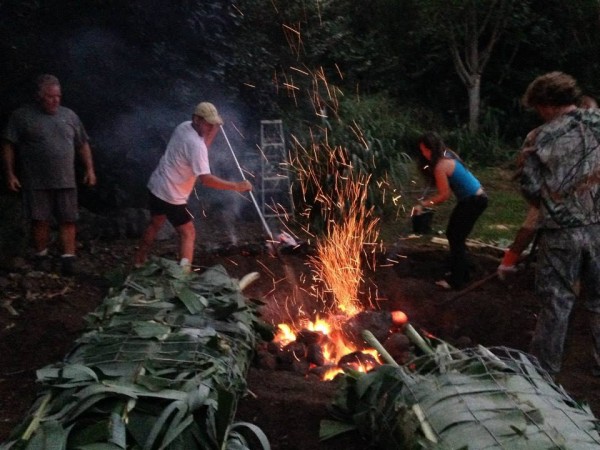
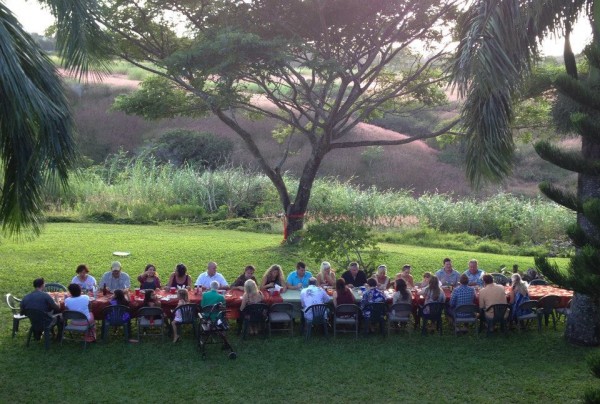


Rena Biel
April 2, 2016
What a wonderful article Tracy. Brings back some lovely memories of delicious food and amazing friends…
Rena Biel
April 2, 2016
What a wonderful article Tracy. Brings back some lovely memories of delicious food and amazing friends…
Mihaela Stoops
April 4, 2016
And I was not invited :-(((((( I will settle for some left overs.
Mihaela Stoops
April 4, 2016
And I was not invited :-(((((( I will settle for some left overs.
jerry labb
November 21, 2017
Wow Lau Lau!!! I can’t believe that it’s you Tracy doing this. Mahalo.
I’m prepping my turkey and I’m going to take it to the Pukalani Church to put in their Imu.
They do it as a community service. I’ll let you know how it turns out. Aloha
Tracy Stice
November 22, 2017
Jerry, I have passed the torch. My son Jeremy and nephew Tim are doing the imu today at my brother Aarons’ house. It is fairly small by historical standards, only about 20 people and 150 pounds of turkey and pork, but it should be fun.
willy
September 9, 2018
Brilliant. Very well explained. Thank you so much. I have this idea of turning my country home into a restaurant, and thanks to you I now have the perfect menu. I would be honored if you gave me some tips on how to spice up this delicacy. My aim is to give my clients an experience they cannot get anywhere in East and Central Africa. Kind regards, and many thanks, Willy.